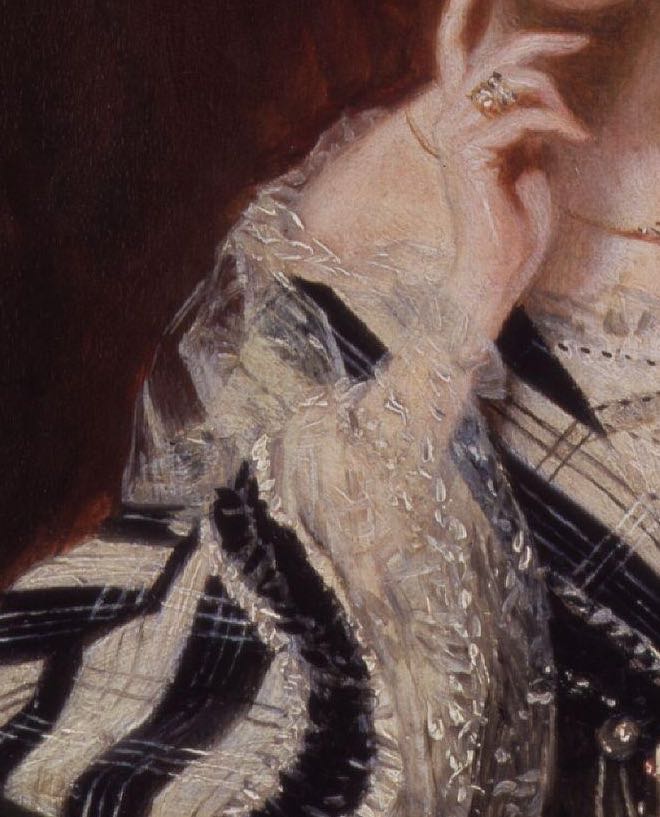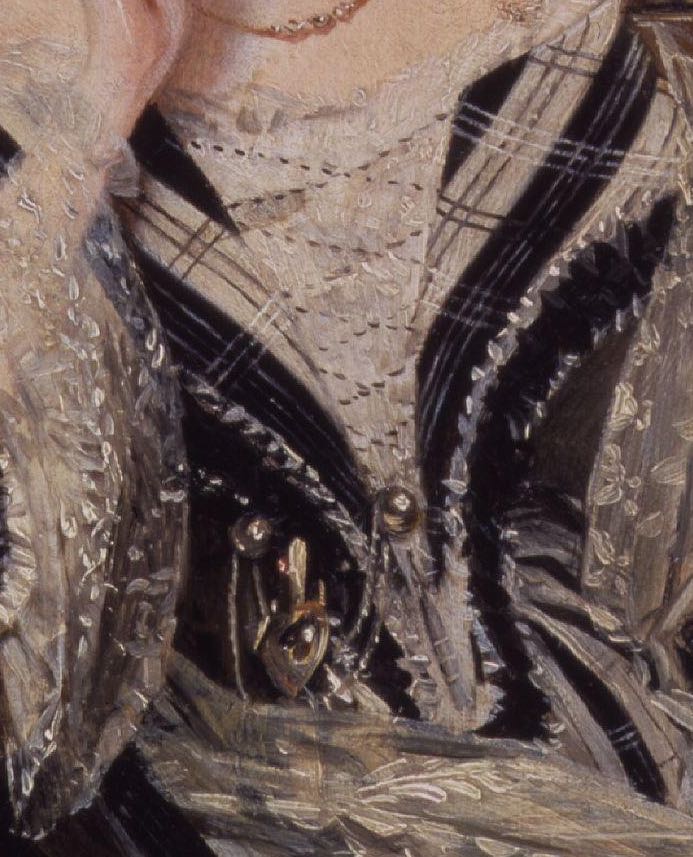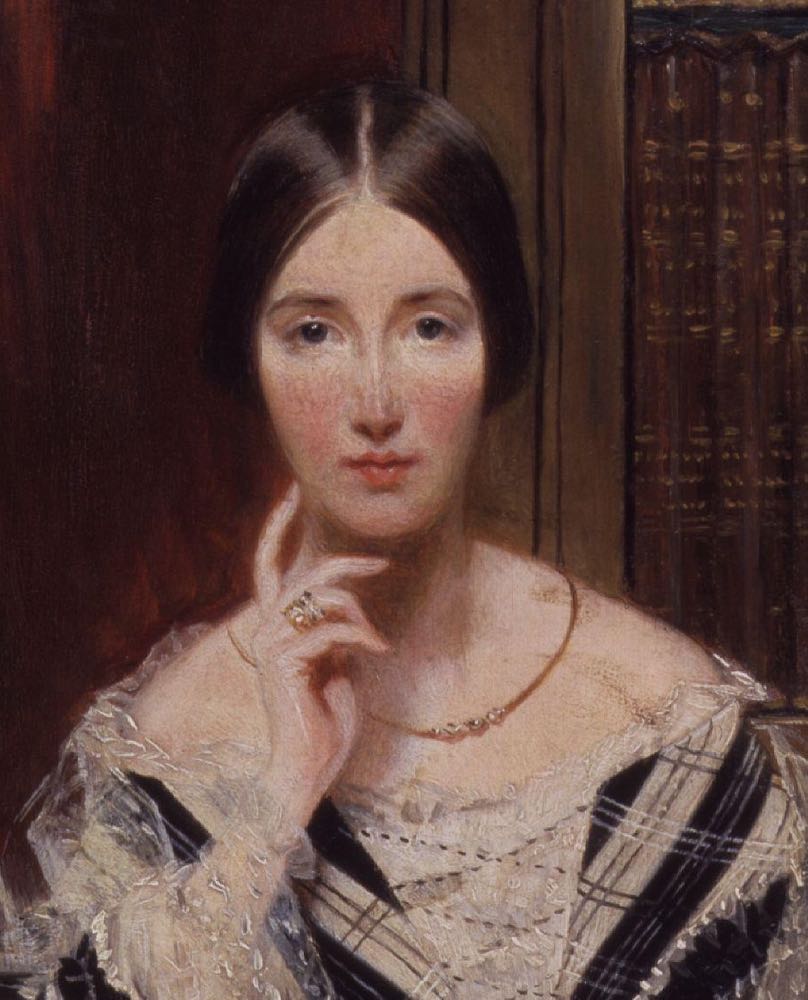Last week’s peach-on-peach 1914 evening dress earned its rating almost entirely on how much you liked said shade. If it was too much overtones of 1980s bridesmaids dresses – not so much! I was highly entertained by the wildly varying opinions and some of the descriptions (peach flavoured onion!). Alas, for something so entertaining, it came in with a rather nondescript rating of 7.3 out of 10. The lowest in a long while, but far higher than some of the lowest scores.
This week let us turn from soft peachy pink, to crisp black and white, as we look at philanthropist, heiress, art collector, honourary beekeeper and goat aficionado, Angela Burdett-Coutts, 1st Baroness Coutts.
Angela’s life is remarkable; from inheriting one of the largest fortunes in England (though I’ve always wondered how her four older sisters felt about being left out of it); to using it for a huge range of Very Good Things (many quite unusual and advanced for a lady of her era); to proposing to the 45-years-her-senior Duke of Wellington, fending off the advances of a slew of fortune hunters, and finally marrying a man 25-years-her-junior, even though it meant giving up most of her fortune.

Angela Georgina Burdett-Coutts, Baroness Burdett-Coutts,ca. 1840, National Portrait Gallery, England, via Wikimedia Commons
Angela’s dress is made from dimensional black and white plaid, with pleated ruffle trim in black and white framing the full bell sleeves and the bertha, and a faux-lacing effect on the front of the dress.
She wears it with sheer, lacy undersleeves, and carries a delicate lace shawl – an accessories she seems to have particularly favoured, as her other portrait of this period also features one prominently.
Her jewellery is remarkably restrained for one of the richest women in England: a chatelaine pinned to her waist, a simple gold necklace, and a stack of rings on one finger, and a single ring on her other hand.
Even her hair is sleek and subdued, keeping the focus on her face and personality:
Despite the huge range of activities she was involved in, and the potential to hugely influence politics, Angela was always remarkably discreet in her own personal opinions, even in areas (such as religion) where even Victorian ideals of retiring womanhood permitted a strong stance.
Do you think that the dress is speaking for her in the right ways? Just strong enough, with that bold pattern, without being ostentatious? Does that mix of trims and pattern balance with the simple (for the era) accessories? All in all, is the outfit as awesome as the woman?
Rate the Dress on a scale of 1 to 10





I find it’s hard to judge what Angela is wearing, simply because her face, and its expressive gaze, command so much attention!
That said, I think the dress suits the lady well. It is bold without being brash, and distinctive without being garish or tacky. I wonder if any of the thin cross-threads were metallic–they seem to be, but it’s always hard to say from a portrait.
9 out of 10. I’d give it a 10, but I suspect that the painter did a bit of fudging here, and the real dress or a photograph of same might not look quite so perfect, as a garment and for the sitter.
This is a very interesting dress! I don’t like the bodice. It draws the eye but something just seems off about it to me. I love the sleeves and the skirt though. The fabric is fantastic and really suits the volume of them both.
7/10
I like the dress! It’s simple, but the plaid gives it a nice flair. What an interesting woman!
Wouldn’t it be fun to see this in real life! I wonder if the plaid is silk taffeta? Of course it would also be fun to chat with the lady wearer in real life, I suspect!
Just for the charm of the painting over all, and imagining the real dress, 10/10.
ceci
I find this quite an arresting dress – the boldness of the plaid offsets the demureness of the style harmoniously. 10 of 10.
9/10 but who cares! So glad to be introduced to this amazing woman!
Awesomely tailored. I like the way the dominant stripe enhances the rounded line of the bodice, and the tucked edging on the sleeve being just the same width as the stripes in the plaid. The light threads in the plaid break up the dominant black striping effectively. I don’t think this would have been as effective in a plain stripe.
It’s feminine and very much in the style of the period without being prissy. And because it reminds me of my favorite childhood dress that was black and white plaid silk taffeta with tucks and ruffles and lace and ribbons (and very prissy but I was only 8)
10/10
I like the dress. It has something very fluid and comfortable about it. I also like the jewellery which I think is very understated and quite lovely. I have to draw the line at her hairstyle though. Boring! It totally numbs me out. She’s got quite attractive features but that hairstyle does her no favours. It actually makes her look a bit like my 1973 Maths teacher! Anyhow I’m giving this one 8/10. She loses 2 points for her numpty hairstyle.
Firstly, thank you for introducing me to such a fascinating woman! I fell into the research rabbit hole after clicking on her Wikipedia link, haha.
As for the dress, I’m a sucker for (properly done) plaid, and this is no exception. I feel like bright colors would be a bit much for this dress, and I’d probably hate the ruffle trim if it wasn’t in black, and overall I’d call this a fairly perfect outfit. The accessories seem splendid, too, in a subdued way that really works with the dress. 10/10, and now, because of the Baroness, I “need” a chatelaine for my next historical make.
Buttercup: the Baroness’s style is a pretty standard Victorian style of the period. However, you’re certainly entitled to find it boring! What kind of style would you have preferred?
This dress manages to grab attention without being garish, not an easy feat with such a loud fabric. I especially like the lines of the bodice, masterful use of the pattern!
I think the pattern alone on the large area of the skirt does not display it to best effect, though.
9/10
P.S.: I would like to suggest that you also evaluate the standard deviations of the ratings (excel can do that for you). I think it would be interesting to see if people agreed very much or if it was a “love it or hate it” dress.
I also think that the total number of votes could be interesting to see. Maybe there are some dresses for which people can’t be bothered to write something because they find them so nondescript or ugly?
If you would like to tally the votes from each week and do all the evaluations you suggest, I’d be delighted. However, it’s all I can manage to post and tally each Rate the Dress each week!
Honestly, I would!
Can you see my email address so you can contact me?
It had to be plaid.
Not being a fan of plaid I still adore it. It does remind me of See’s Candies though.
The smooth hairdo shows off M’lady’s very fashionable fine brown hair. Queen Victoria’s hair was of the same shade & texture and she was quite vain about it.
10/10
I’ve always read that QVs hair was a very light brown, almost blonde, when she was a young woman, not Angela’s dark chestnut. Pale mouse-brown-blonde is certainly what is shown in paintings of the young QV, and I think there are even a few locks of her youthful hair preserved. Will have to look it up!
I love this. the 1840s are a decade I’m particularly fond of, where they have more grace than the rather top-heavy feeling dresses of the 1830s but the crinoline hasn’t yet begun to turn into a bustle. I love how subtle the plaid is – you could almost mistake it for stripes, at a distance, and it’s not overwhelming to have it over the entire garment the way some plaids are. I love the way the bold pattern contrasts against the soft lace. The restraint in jewelry is nice, as well – more and it would have busied the overall appearance too much. I just wish we could see her in a different position – I’m curious as to how much of the folds on the skirt are because of the way she’s sitting, and something looks odd about her waist/arm area, as well(her left arm – is her arm really that small? did the artist forget to draw a line? it puzzles me).
I also think the colors, if painted accurately, suit her very well, and the hair matches the geometry of the dress nicely. I adore the big sleeves. 10/10